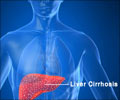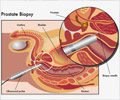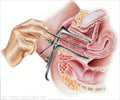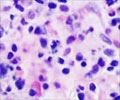A new imaging technique developed by the Mayo Clinic, US can identify liver fibrosis with greater accuracy and help eliminate the need for liver biopsy.
A new imaging technique developed by the Mayo Clinic, US can identify liver fibrosis with greater accuracy and help eliminate the need for livery biopsy. Liver fibrosis is a common condition that can lead to incurable cirrhosis if not treated in time.
The technology, called magnetic resonance elastography (MRE), produces color-coded images known as elastograms that indicate how internal organs, muscles and tissues would feel to the touch. Red is the stiffest; purple, the softest. Other imaging techniques do not provide this information."Knowing the liver's elasticity or stiffness is invaluable in diagnosing liver disease," says Jayant Talwalkar, a Mayo Clinic hepatologist and co-investigator on the study. "A healthy liver is very soft, while a liver with early disease begins to stiffen. A liver with cirrhosis, advanced liver disease, can be rock hard."
The study, which included 113 patients, will be presented Nov. 3 at The Liver Meeting, an annual gathering of the American Association for the Study of Liver Disease, in San Francisco. Study participants had undergone liver biopsy in the year preceding the study and had a wide variety of liver diseases, including nonalcoholic and alcoholic fatty liver disease, hepatitis C, hepatitis B, autoimmune hepatitis, primary biliary cirrhosis and primary sclerosing cholangitis. Patients ranged in age from 19 to 78, and their body weight ranged from normal to severely obese.
"Results showed that elastography was highly accurate in detecting moderate-to-severe hepatic fibrosis even with the variety in age, types of liver disease and body size," says Dr. Talwalkar. Among the study's findings:
The detection of cirrhosis by MRE when compared to liver biopsy results was 88 percent accurate.
Patients with nonalcoholic fatty liver disease and no significant inflammation or fibrosis were identified with 97 percent accuracy.
Liver biopsies, conducted by extracting tissue samples with a needle, can underestimate the degree of hepatic fibrosis about 20 to 30 percent of the time because of the patchy distribution of fibrosis that occurs in the liver. Another drawback is that since liver biopsy is invasive, patients may be reluctant to have a biopsy performed and sometimes delay the procedure when liver disease is first suspected, says Dr. Talwalkar.
The incidence and prevalence of chronic liver disease is increasing in the United States. Nonalcoholic fatty liver disease has become the most common liver disease and is linked to the growing numbers of patients with obesity and diabetes. The number of patients seeking medical care for hepatitis C is also increasing. This disease, spread by coming into contact with blood contaminated by the virus, slowly damages the liver over decades.
MRE research began at Mayo Clinic about 10 years ago. The technology measures low-frequency acoustic waves transmitted into the abdomen. The wave motions measured are miniscule, 0.01 of the width of a human hair.
The noninvasive procedure takes seconds to conduct. Mayo Clinic is already using MRE to diagnose patients with liver conditions. Research is under way to study how MRE might aid in the diagnosis of Alzheimer's disease and some cancers.
Source-Medindia
GPL/S
 MEDINDIA
MEDINDIA


 Email
Email










